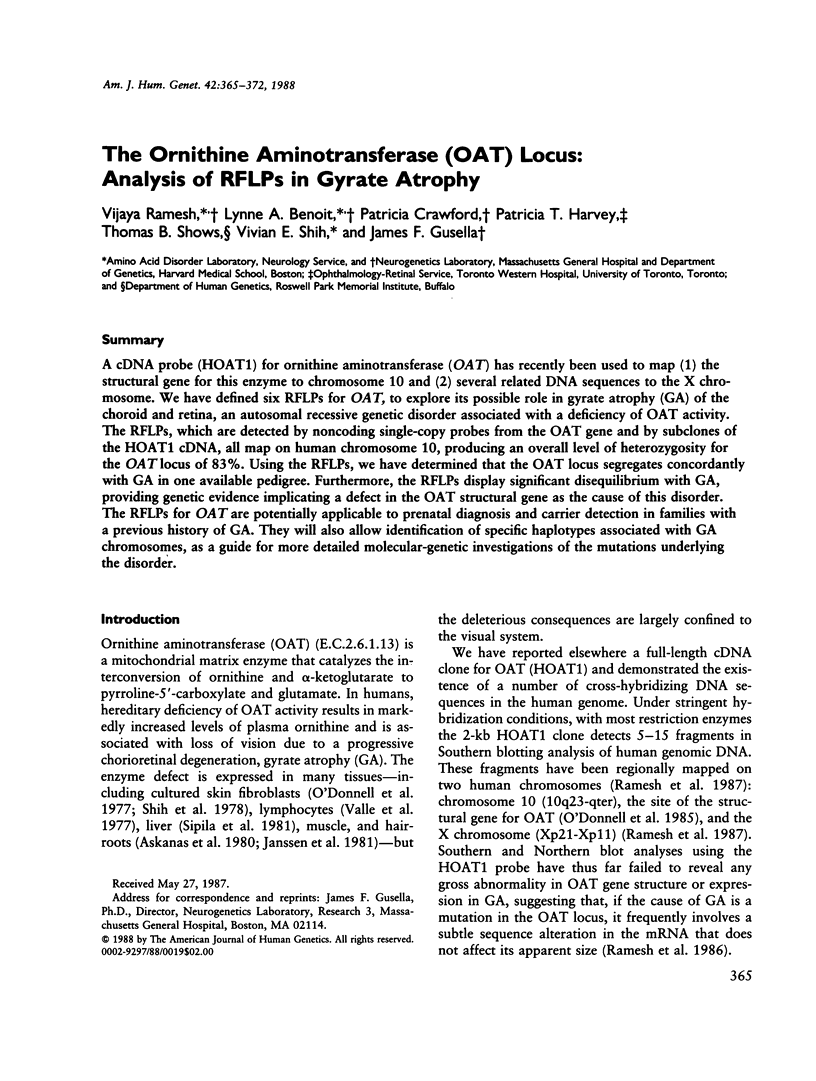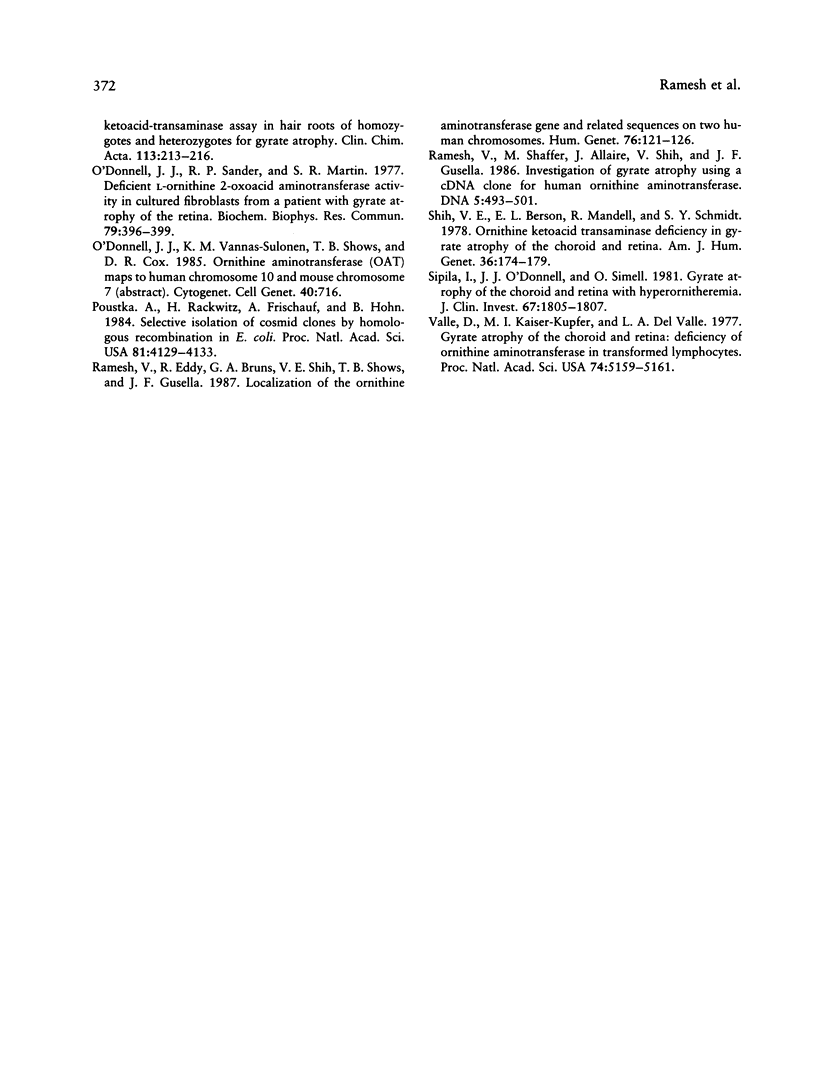Abstract
A cDNA probe (HOAT1) for ornithine aminotransferase (OAT) has recently been used to map (1) the structural gene for this enzyme to chromosome 10 and (2) several related DNA sequences to the X chromosome. We have defined six RFLPs for OAT, to explore its possible role in gyrate atrophy (GA) of the choroid and retina, an autosomal recessive genetic disorder associated with a deficiency of OAT activity. The RFLPs, which are detected by noncoding single-copy probes from the OAT gene and by subclones of the HOAT1 cDNA, all map on human chromosome 10, producing an overall level of heterozygosity for the OAT locus of 83%. Using the RFLPs, we have determined that the OAT locus segregates concordantly with GA in one available pedigree. Furthermore, the RFLPs display significant disequilibrium with GA, providing genetic evidence implicating a defect in the OAT structural gene as the cause of this disorder. The RFLPs for OAT are potentially applicable to prenatal diagnosis and carrier detection in families with a previous history of GA. They will also allow identification of specific haplotypes associated with GA chromosomes, as a guide for more detailed molecular-genetic investigations of the mutations underlying the disorder.
Full text
PDF







Images in this article
Selected References
These references are in PubMed. This may not be the complete list of references from this article.
- Anderson M. A., Gusella J. F. Use of cyclosporin A in establishing Epstein-Barr virus-transformed human lymphoblastoid cell lines. In Vitro. 1984 Nov;20(11):856–858. doi: 10.1007/BF02619631. [DOI] [PubMed] [Google Scholar]
- Feinberg A. P., Vogelstein B. "A technique for radiolabeling DNA restriction endonuclease fragments to high specific activity". Addendum. Anal Biochem. 1984 Feb;137(1):266–267. doi: 10.1016/0003-2697(84)90381-6. [DOI] [PubMed] [Google Scholar]
- Gusella J. F., Wexler N. S., Conneally P. M., Naylor S. L., Anderson M. A., Tanzi R. E., Watkins P. C., Ottina K., Wallace M. R., Sakaguchi A. Y. A polymorphic DNA marker genetically linked to Huntington's disease. Nature. 1983 Nov 17;306(5940):234–238. doi: 10.1038/306234a0. [DOI] [PubMed] [Google Scholar]
- Gusella J., Varsanyi-Breiner A., Kao F. T., Jones C., Puck T. T., Keys C., Orkin S., Housman D. Precise localization of human beta-globin gene complex on chromosome 11. Proc Natl Acad Sci U S A. 1979 Oct;76(10):5239–5242. doi: 10.1073/pnas.76.10.5239. [DOI] [PMC free article] [PubMed] [Google Scholar]
- Janssen A. J., Plakké T., Trijbels F. J., Sengers R. C., Monnens L. A. L-Ornithine ketoacid-transaminase assay in hair roots of homozygotes and heterozygotes for gyrate atrophy. Clin Chim Acta. 1981 Jun 18;113(2):213–216. doi: 10.1016/0009-8981(81)90156-x. [DOI] [PubMed] [Google Scholar]
- O'Donnell J. J., Sandman R. P., Martin S. R. Deficient L-ornithine: 2-oxoacid aminotransferase activity in cultured fibroblasts from a patient with gyrate atrophy of the retina. Biochem Biophys Res Commun. 1977 Nov 21;79(2):396–399. doi: 10.1016/0006-291x(77)90170-x. [DOI] [PubMed] [Google Scholar]
- Poustka A., Rackwitz H. R., Frischauf A. M., Hohn B., Lehrach H. Selective isolation of cosmid clones by homologous recombination in Escherichia coli. Proc Natl Acad Sci U S A. 1984 Jul;81(13):4129–4133. doi: 10.1073/pnas.81.13.4129. [DOI] [PMC free article] [PubMed] [Google Scholar]
- Ramesh V., Eddy R., Bruns G. A., Shih V. E., Shows T. B., Gusella J. F. Localization of the ornithine aminotransferase gene and related sequences on two human chromosomes. Hum Genet. 1987 Jun;76(2):121–126. doi: 10.1007/BF00284906. [DOI] [PubMed] [Google Scholar]
- Ramesh V., Shaffer M. M., Allaire J. M., Shih V. E., Gusella J. F. Investigation of gyrate atrophy using a cDNA clone for human ornithine aminotransferase. DNA. 1986 Dec;5(6):493–501. doi: 10.1089/dna.1.1986.5.493. [DOI] [PubMed] [Google Scholar]
- Shih V. E., Berson E. L., Mandell R., Schmidt S. Y. Ornithine ketoacid transaminase deficiency in gyrate atrophy of the choroid and retina. Am J Hum Genet. 1978 Mar;30(2):174–179. [PMC free article] [PubMed] [Google Scholar]
- Sipilä I., Simell O., O'Donnell J. J. Gyrate atrophy of the choroid and retina with hyperornithinemia: characterization of mutant liver L-ornithine:2-oxoacid aminotransferase kinetics. J Clin Invest. 1981 Jun;67(6):1805–1807. doi: 10.1172/JCI110222. [DOI] [PMC free article] [PubMed] [Google Scholar]
- Valle D., Kaiser-Kupfer M. I., Del Valle L. A. Gyrate atrophy of the choroid and retina: deficiency of ornithine aminotransferase in transformed lymphocytes. Proc Natl Acad Sci U S A. 1977 Nov;74(11):5159–5161. doi: 10.1073/pnas.74.11.5159. [DOI] [PMC free article] [PubMed] [Google Scholar]





